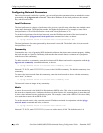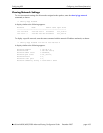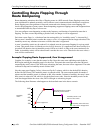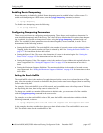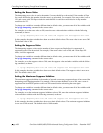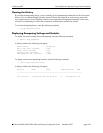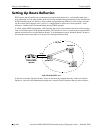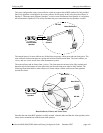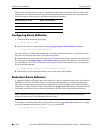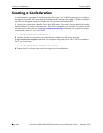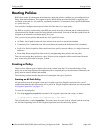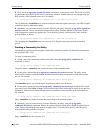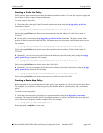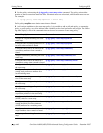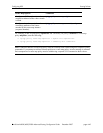
Setting Up Route Reflection Configuring BGP
page 4-42 OmniSwitch 6800/6850/9000 Advanced Routing Configuration Guide December 2007
When a route reflector receives a route it, selects the best path based on its policy decision criteria. The
internal peers to which the route reflector advertises depends on the source of the route. The table below
shows the rules the reflector follows when advertising path information:
Configuring Route Reflection
1 Disable the BGP protocol by specifying:
-> ip bgp status disable
2 Specify this router as a route reflector, using the ip bgp client-to-client reflection command:
-> ip bgp client-to-client reflection
The route reflector will follow the standard rules for client route advertisement (i.e., routes from a client
are sent to all clients and non-clients, except the source client).
3 Indicate the client peers for this route reflector. For all internal peers (same AS as the router) that are to
be clients specify the ip bgp neighbor route-reflector-client command. For example, if you wanted the
peer at IP address 190.17.20.16 to become a client to the local BGP route-reflector, then you would spec-
ify the following command:
-> ip bgp neighbor 190.17.20.16 route-reflector-client
4 Repeat Step 3 for all internal peers that are to be clients of the route reflector.
Redundant Route Reflectors
A single BGP speaker will usually act as the reflector for a cluster of clients. In such a case, the cluster is
identified by the router ID of the reflector. It is possible to add redundancy to a cluster by configuring
more than one route reflector, eliminating the single point of failure. Redundant route reflectors must be
identified by a 4-byte cluster ID, which is specified in the ip bgp cluster-id command. All route reflectors
in the same cluster must be fully meshed and should have the exact same client and non-client peers.
Note. Using many redundant reflectors is not recommended as it places demands on the memory
required to store routes for all redundant reflectors’ peers.
To configure a redundant route reflector for this router, use the ip bgp cluster-id command. For example
to set up a redundant route reflector at 190.17.21.16, you would enter:
-> ip bgp cluster-id 190.17.21.16
Route Received From... Route Advertised To...
External BGP Router All Clients and Non-Clients
Non-Client Peer All Clients
Client Peer All Clients and Non-Clients



